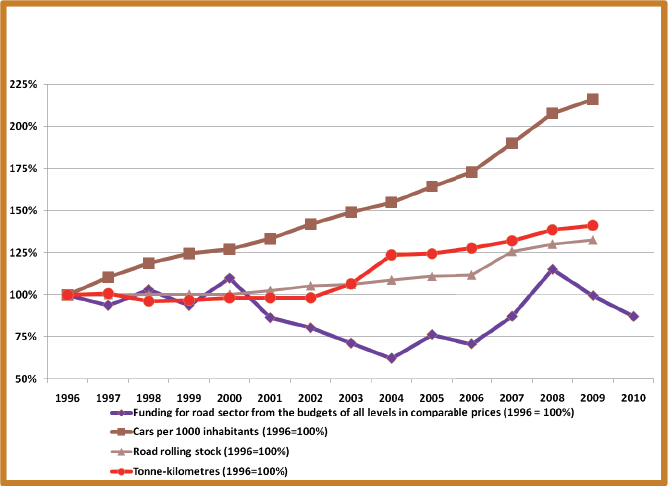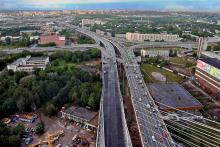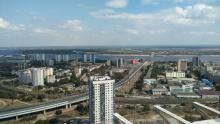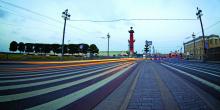What is the current situation with Russian roads? It is an objective answer to this question that is contained in the official report of the Federal State Statistics Service for 2009. Here it states: "...public roads are of poor quality: 8.4% of roads accounted for groundwater, nearly a third of roads are gravel, rubble or cobblestone.

Figure 3
What is the current situation with Russian roads? It is an objective answer to this question that is contained in the official report of the Federal State Statistics Service for 2009. Here it states: "...public roads are of poor quality: 8.4% of roads accounted for groundwater, nearly a third of roads are gravel, rubble or cobblestone. Currently 29.1% of rural settlements do not have paved roads to link with a national network of roads and railways."
According to the same source, the density of the road network is 35km of roads per 1,000km² of territory, which is much lower than in developed countries.
The2865 Federal Highway Agency, 2002-2009, says that some 24,000km of paved roads years were put into operation, and at the same time as recorded in government statistics there was almost no increase in the length of paved roads (Fig. 1).
There is no contradiction: the majority of road projects in recent years were aimed at the reconstruction of existing roads, but not on building new ones. In addition, some parts of the local network, due to wear and tear year flows from paved roads in the category of roads with so-called transitional type, or even the gravel roads.
The most visible cause of all these problems is identified as the level of funding of national roads, which is very low as compared with the size of gross domestic product/GDP (Fig. 2), and with the growth in demand for road use.
It is easy to see that even during the years of oil prosperity the level of expenditure on roads from the budgets of all levels did not tend to increase. The local maximum of 1.55% of GDP, which was made in 2008, signified the beginning of a very modest (in comparison with the scale of the country) mark of US$20 billion.
Even more revealing is the comparison of expenditure patterns in the road sector with the increasing demand for road use (Fig. 3). Over the past 15 years the level of car ownership of households has increased in 2.2 times, while the number of tonnes-kilometres of road transport increased by 40%. During the same period expenditure on roads (taken at constant prices) has undergone significant variations, but has in no way increased.
The bulk of budgetary allocations in recent years have focused on a few programmes and projects mainly in Moscow, the Russian capital, as well as ambitious international events.
These have included reconstruction of the main thoroughfares of Moscow, where it was disbursed to 20% of the total investment in national roads; reconstruction of the head sections of federal roads in the nearby suburbs of Moscow, in particular highways M-3 Ukraine and M-8 Kholmogory; continued construction of ring road in St Petersburg, and development of the transport infrastructure of Sochi in preparation for the Winter Olympic Games in 2014. A new bypass of the city was also put into operation.
Another project for an international event is the construction of bridges from Vladivostok to Russkiy Island in preparation for the APEC (2868 Asia-Pacific Economic Cooperation) summit in 2012.
Among the non-capital projects worthy of mention are continued construction of the road M-58 Amur from Chita to Khabarovsk; reconstruction of the busiest sections of a number of federal roads including the M-5 Ural, M-4 Don and M-8 Kholmogory, and construction of a number of extra-curricular bridges on federal roads.
Of course, this list could continue, but in all cases the volume of road construction in Russia should be recognised as being the more than modest.
For many years the economic and transport agencies of Russia have raised the question of the need to attract private investment in road construction under concession agreements for the construction and operation of toll roads.
To date two such projects have been launched through public-private partnerships (PPPs): the federal highway M-1 Belarus on the Moscow ring road (bypassing the city Odintsovo with a length of about 20km) and 43km of the planned new expressway from Moscow to St Petersburg.
The problem of Russian roads is more than a matter of money. Cross-country comparisons show that we are building a slow, expensive and not very high quality system.
Fig. 4 shows the cost per 1km lane of Moscow facilities constructed in recent years.
These prices are consistent with the world level, which unfortunately cannot be said about the quality of roads and traffic conditions in the capital.
The level of engineering road works has improved, but it still falls far short of modern foreign samples.
Global transport planning, design practices and estimate work, assessment of roads and their capacity, the practice of preparation, execution and financing of the contracts: all these issues are resolved often based on outdated or inefficient standards and regulations.
We have yet to generate and put into practice the Russian analogues of such guidance documents as the Highway Design Manual, Contract Administration Core Curriculum Participant's Manual and Reference Guide and Highway Capacity Manual.
Meanwhile, Russia is actively searching for more effective governance mechanisms and financing of road sector.
Important initiatives in this area were made by Russian President Dmitry Medvedev, who suggested going back to the idea of road funds similar to the US Highway Trust Fund as well as considering the application in Russia of standards for design and construction of roads similar to those operating in the1116 European Union.
However, the state company Avtodor has been established, and federal laws gave Avtodor extensive powers of control in the construction and operation of highways by attracting private investment and the organisation of PPPs including concessions and life-cycle contracts. Recently adopted regulations by the Russian government have provided sovereign guarantees for so-called infrastructure bonds issued by Avtodor.
In expert circles in Russia, the idea is being gradually adopted that good road conditions in all cases will have to be paid for by the users.
Today, users (through excise taxes on motor fuels and vehicles as well as a transport tax) pay only 40% of total budget expenditure on roads of the country (Fig. 5).
Radical changes in the field of road funding (and soon after this in the road sector in general) will only start when society and the political elite are willing to substantially increase the tax burden on car ownership and road use.
Mikhail Blinkin is Director of Research Programmes at the Transport and Road Engineering Scientific Research Institute in Moscow.
According to the same source, the density of the road network is 35km of roads per 1,000km² of territory, which is much lower than in developed countries.
The
There is no contradiction: the majority of road projects in recent years were aimed at the reconstruction of existing roads, but not on building new ones. In addition, some parts of the local network, due to wear and tear year flows from paved roads in the category of roads with so-called transitional type, or even the gravel roads.
The most visible cause of all these problems is identified as the level of funding of national roads, which is very low as compared with the size of gross domestic product/GDP (Fig. 2), and with the growth in demand for road use.
It is easy to see that even during the years of oil prosperity the level of expenditure on roads from the budgets of all levels did not tend to increase. The local maximum of 1.55% of GDP, which was made in 2008, signified the beginning of a very modest (in comparison with the scale of the country) mark of US$20 billion.
Even more revealing is the comparison of expenditure patterns in the road sector with the increasing demand for road use (Fig. 3). Over the past 15 years the level of car ownership of households has increased in 2.2 times, while the number of tonnes-kilometres of road transport increased by 40%. During the same period expenditure on roads (taken at constant prices) has undergone significant variations, but has in no way increased.
The bulk of budgetary allocations in recent years have focused on a few programmes and projects mainly in Moscow, the Russian capital, as well as ambitious international events.
These have included reconstruction of the main thoroughfares of Moscow, where it was disbursed to 20% of the total investment in national roads; reconstruction of the head sections of federal roads in the nearby suburbs of Moscow, in particular highways M-3 Ukraine and M-8 Kholmogory; continued construction of ring road in St Petersburg, and development of the transport infrastructure of Sochi in preparation for the Winter Olympic Games in 2014. A new bypass of the city was also put into operation.
Another project for an international event is the construction of bridges from Vladivostok to Russkiy Island in preparation for the APEC (
Among the non-capital projects worthy of mention are continued construction of the road M-58 Amur from Chita to Khabarovsk; reconstruction of the busiest sections of a number of federal roads including the M-5 Ural, M-4 Don and M-8 Kholmogory, and construction of a number of extra-curricular bridges on federal roads.
Of course, this list could continue, but in all cases the volume of road construction in Russia should be recognised as being the more than modest.
For many years the economic and transport agencies of Russia have raised the question of the need to attract private investment in road construction under concession agreements for the construction and operation of toll roads.
To date two such projects have been launched through public-private partnerships (PPPs): the federal highway M-1 Belarus on the Moscow ring road (bypassing the city Odintsovo with a length of about 20km) and 43km of the planned new expressway from Moscow to St Petersburg.
The problem of Russian roads is more than a matter of money. Cross-country comparisons show that we are building a slow, expensive and not very high quality system.
Fig. 4 shows the cost per 1km lane of Moscow facilities constructed in recent years.
These prices are consistent with the world level, which unfortunately cannot be said about the quality of roads and traffic conditions in the capital.
The level of engineering road works has improved, but it still falls far short of modern foreign samples.
Global transport planning, design practices and estimate work, assessment of roads and their capacity, the practice of preparation, execution and financing of the contracts: all these issues are resolved often based on outdated or inefficient standards and regulations.
We have yet to generate and put into practice the Russian analogues of such guidance documents as the Highway Design Manual, Contract Administration Core Curriculum Participant's Manual and Reference Guide and Highway Capacity Manual.
Meanwhile, Russia is actively searching for more effective governance mechanisms and financing of road sector.
Important initiatives in this area were made by Russian President Dmitry Medvedev, who suggested going back to the idea of road funds similar to the US Highway Trust Fund as well as considering the application in Russia of standards for design and construction of roads similar to those operating in the
However, the state company Avtodor has been established, and federal laws gave Avtodor extensive powers of control in the construction and operation of highways by attracting private investment and the organisation of PPPs including concessions and life-cycle contracts. Recently adopted regulations by the Russian government have provided sovereign guarantees for so-called infrastructure bonds issued by Avtodor.
In expert circles in Russia, the idea is being gradually adopted that good road conditions in all cases will have to be paid for by the users.
Today, users (through excise taxes on motor fuels and vehicles as well as a transport tax) pay only 40% of total budget expenditure on roads of the country (Fig. 5).
Radical changes in the field of road funding (and soon after this in the road sector in general) will only start when society and the political elite are willing to substantially increase the tax burden on car ownership and road use.
Mikhail Blinkin is Director of Research Programmes at the Transport and Road Engineering Scientific Research Institute in Moscow.









